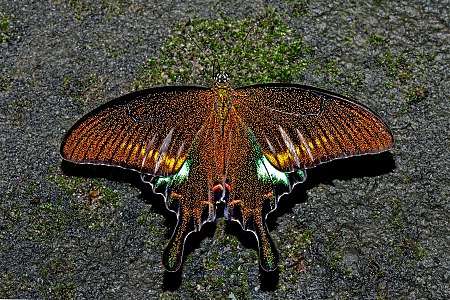Papilio bianor
| Papilio bianor | |
|---|---|
 | |
| Dorsal View | |
| Scientific classification | |
| Kingdom: | Animalia |
| Phylum: | Arthropoda |
| Class: | Insecta |
| Order: | Lepidoptera |
| Family: | Papilionidae |
| Genus: | Papilio |
| Species: | P. bianor |
| Binomial name | |
| Papilio bianor Cramer, 1777 | |
| Synonyms | |
|
Papilio polyctor | |
Papilio bianor, the Chinese peacock black swallowtail emerald[1] or Chinese peacock is a species of butterfly in the family Papilionidae, the swallowtails.[2] It is native to Asia and Australia.[3] Three of its subspecies are also known as West Himalayan common peacock, East Himalayan common peacock and Indo-Chinese common peacock.[4] The subspecies Papilio bianor polyctor (better known as West Himalayan common peacock) is the state butterfly of the Indian state Uttarakhand.[5][6]
Description
This species is variable in size. Individuals emerged in the spring reach 4 to 8 centimeters wide, while those emerged in the summer can reach 12 centimeters.[1] The forewings are black with dark veining and green scales. The undersides are brown, turning white distally with dark veining. The hindwings are tailed and have ridged edges containing reddish eyespots. The body is black with green scales.[3]
The male has black hair on the forewings, which the female lacks.[1]
Subspecies
There are many subspecies.[3]
- P. b. okinawensis (Yaeyama islands, Okinawa, Japan)
- P. b. ryukyuensis (Okinawa islands, Japan)
- P. b. amamiensis (Amami islands, Kagoshima, Japan)
- P. b. tokaraensis (Tokara islands, Kagoshima, Japan)
- P. b. hachijonis (Hachijo island, Izu islands, Japan)
- P. b. kotoensis Sonan, 1927 (Taiwan)
- P. b. thrasymedes Fruhstorfer 1909 (Taiwan)
- P. b. polyctor Boisduval, 1836 (West Himalayan Common Peacock)
- P. b. ganesa Doubleday, 1842 (East Himalayan Common Peacock)
- P. b. gladiator Fruhstorfer, 1902 (Indo-Chinese Common Peacock)
Biology
This species can be found in forests and other wooded areas. It can occur in suburban and urban areas if appropriate host plants are available.[1]
Food plants include species of citrus, prickly ash, cork trees, trifoliate orange, rue, and Japanese skimmia.[3]
References
- 1 2 3 4 Perveen, F., Khan, A., and Sikander. (2014). Characteristics of butterfly (Lepidoptera) fauna from Kabal, Swat, Pakistan. Journal of Entomology and Zoology Studies 2(1) 56-69.
- ↑ Dong, Y., et al. (2013). The complete mitochondrial genome of the Chinese peacock, Papilio bianor (Insecta: Lepidoptera: Papilionidae). Mitochondrial DNA 24(6), 636-638.
- 1 2 3 4 Papilio bianor. butterflycorner.net
- ↑ https://www.ifoundbutterflies.org/sp/1018/Papilio-bianor
- ↑ "Archived copy". Archived from the original on 8 January 2017. Retrieved 7 January 2017.
- ↑ "Archived copy". Archived from the original on 2 January 2017. Retrieved 9 January 2017.
Sources
- Bauer, E. and Frankenbach, T. 1998 Schmetterlinge der Erde (Butterflies of the World), Part 1: Papilionidae. Keltern: Goecke & Evers, Canterbury: Hillside Books. ISBN 9783931374624
- Igarashi, S. and Fukuda, H. The Life Histories of Asian Butterflies, Volume 1. Tokyo: Tokai University Press. 1997.
- Moriue, N. and Hayashi, M. The Handbook of Insects and their Host Plants. Bun-ichi Sougou Shuppan. 2007. ISBN 978-4-8299-0026-0